Basketball drills
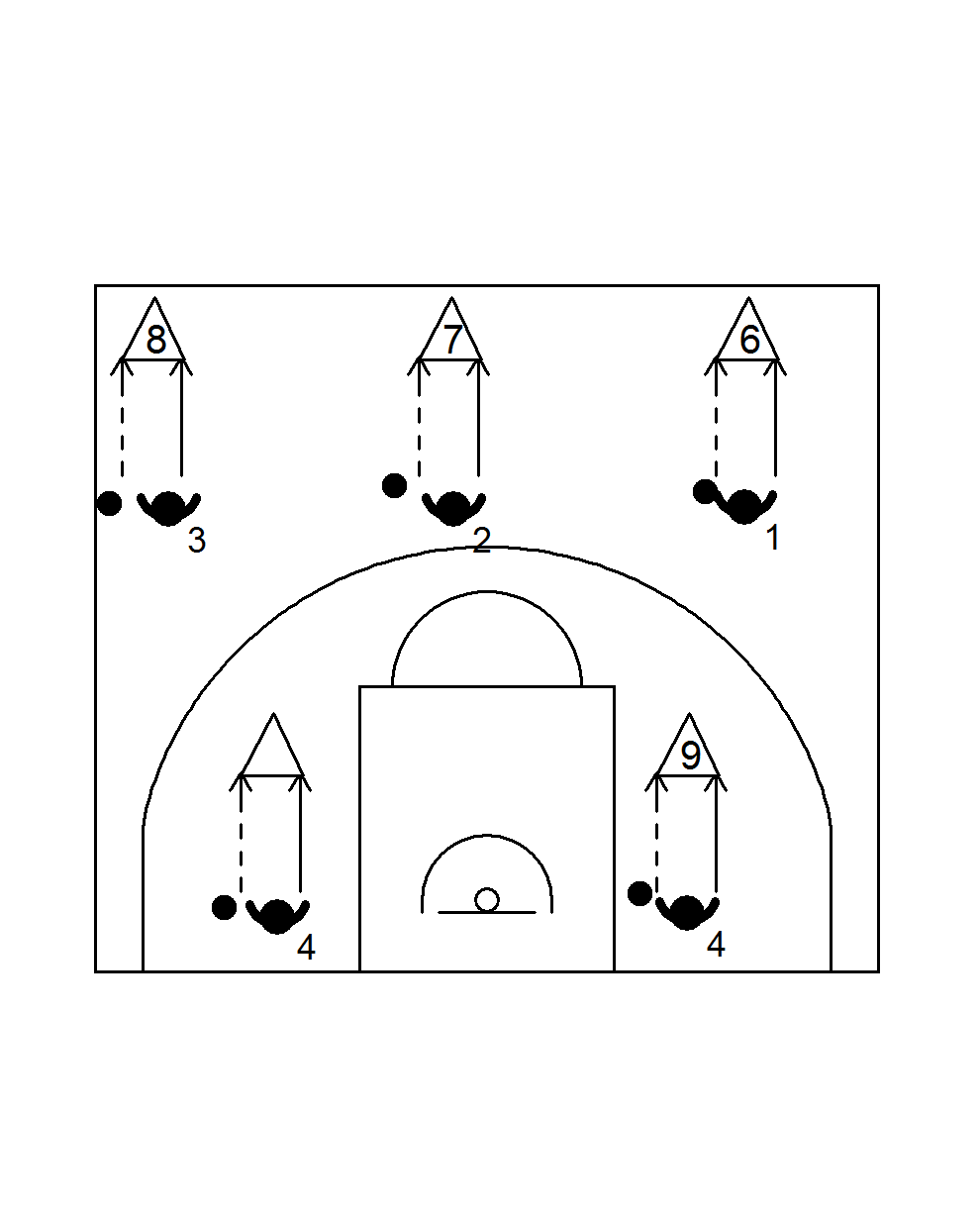
Goal: defend the dribbler after stopping the dribble
Organization:
- man with ball passes to opponent when trainer whistles
- who takes 1 bounce and stops the dribble in 2 Count Rhythm (2TR)
- The trainer counts down 5 seconds and then blows his whistle as end signal
- The aggressive defender steps back to his starting position
- The roles are now reversed
- As soon as the trainer whistles you pass the ball to the other player
- go for it aggressively straight away
- Try to prevent the other player from passing by keeping your hand in front of the ball (trace the ball)
- Try to get your feet to the left and right of the pivot foot of the man with the ball so that he cannot turn
Teaching Points:
- avoid mistakes; do not hit the ball
- Go for the 5 seconds
- Get as close as possible to the attacker (but stay in your own cylinder)
- Move your feet closer to the attacker, but keep your position between the attacker and the basket.
Variations:
- a third man to whom the ball must be passed within 5 seconds. Choose a limited area in which the third man can run free (use lines on the court, or place pawns).
- Pass from under the board to the player on the block. This player must try to pivot past the defender and score. Winner becomes attacker on the block, loser passes from the back line.
Form of play:
- Ten ball on the half court, where the receiver of the ball has to make a dribble start with 1 bounce before he can pass the ball on.
- idem, but defence MUST double team the man with the ball.
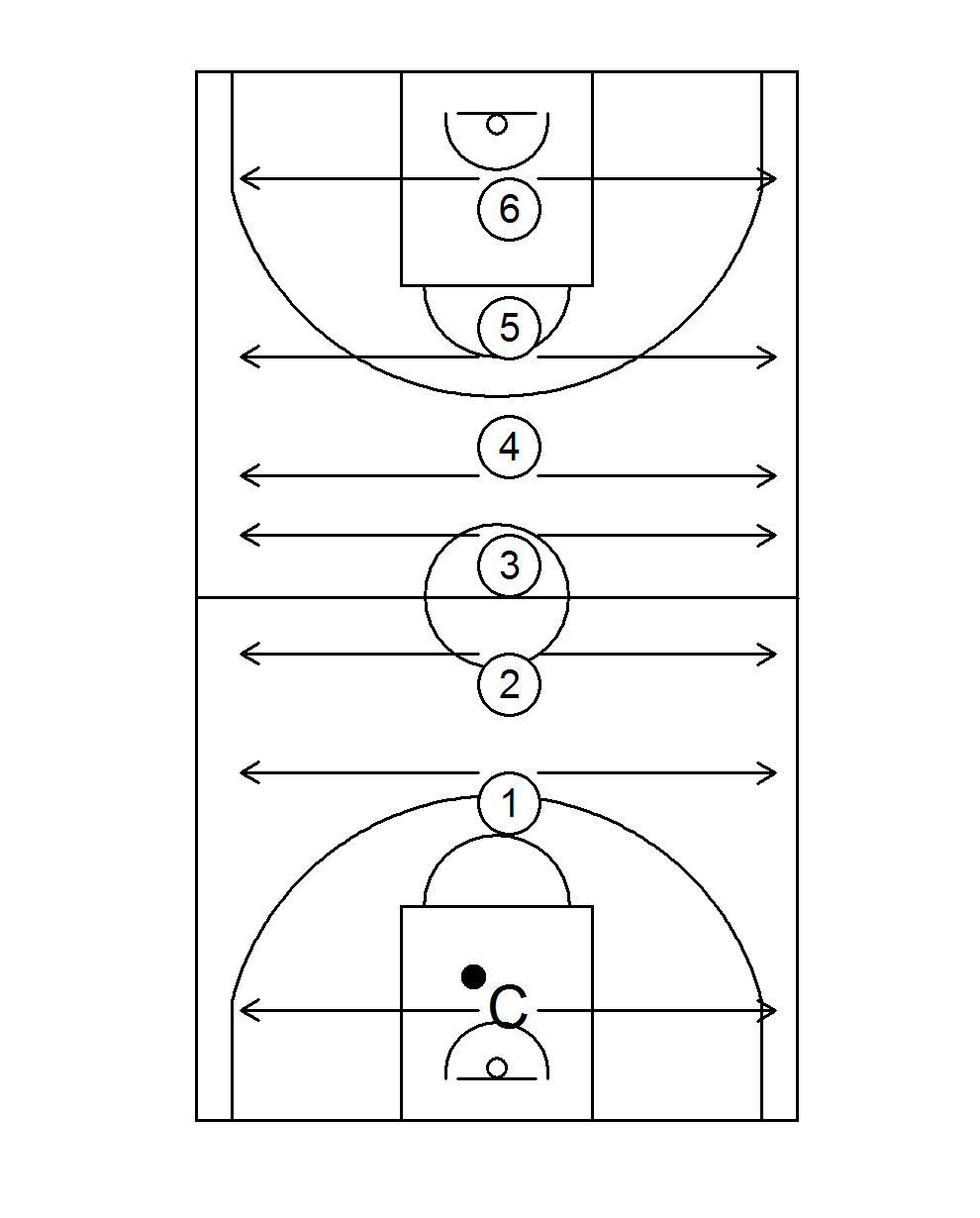
Goal: learn or improve side slides + condition
Organization:
- all players on the helpline, facing the coach
- when coach bounces the ball all players jump into defensive position
- coach moves to the left or to the right, parallel to the backline
- players must stay with their face right in front of the ball
- increase the level of difficulty by changing direction and/or speed at random
Teaching Points:
- feet at least shoulder width
- knees at about 100 degrees (= sitting down deeply)
- shoulders above the heels (= back straight)
- Head upright (overlook the field)
- Hand closest to the ball is low (to be able to tap the ball away on the dribble)
- Other hand is above the shoulder (to intercept a pass)
- push hard on the push-off leg to gain speed
- Feet stay low to the ground (= slide, shuffle)
- feet do not connect after a slide, but remain at shoulder width
Variations:
- let the defender keep his hands on his back if you want to accentuate the feet and stance.
- 1 slide and back to the sideline, 2 slides and back etc. until you reach the sideline; followed by a short fierce sprint back to the sideline
- first a drop step and then slides backwards to the sideline + sprint back
- idem, but first a little tap (quickly transfer weight from one foot to the other)
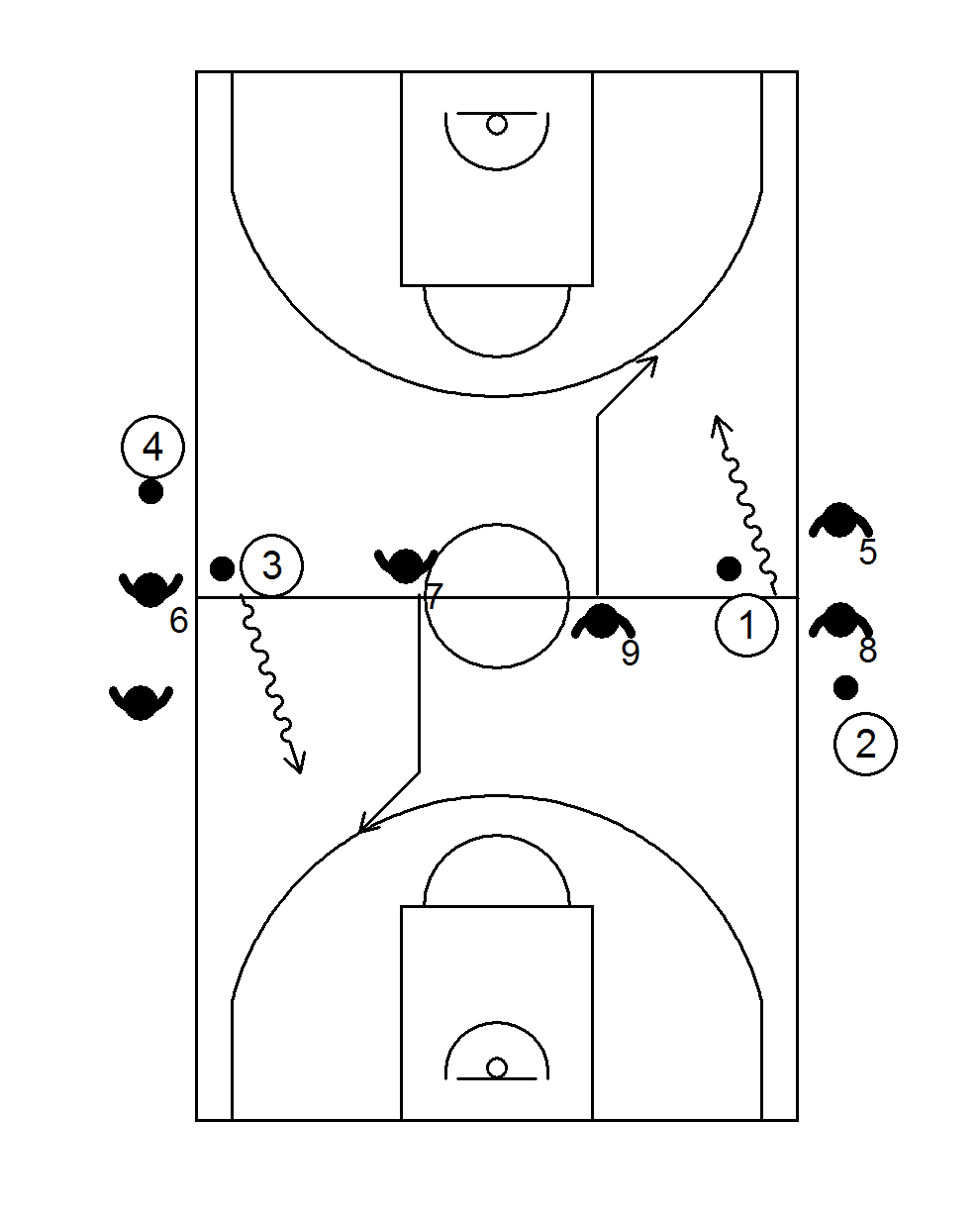
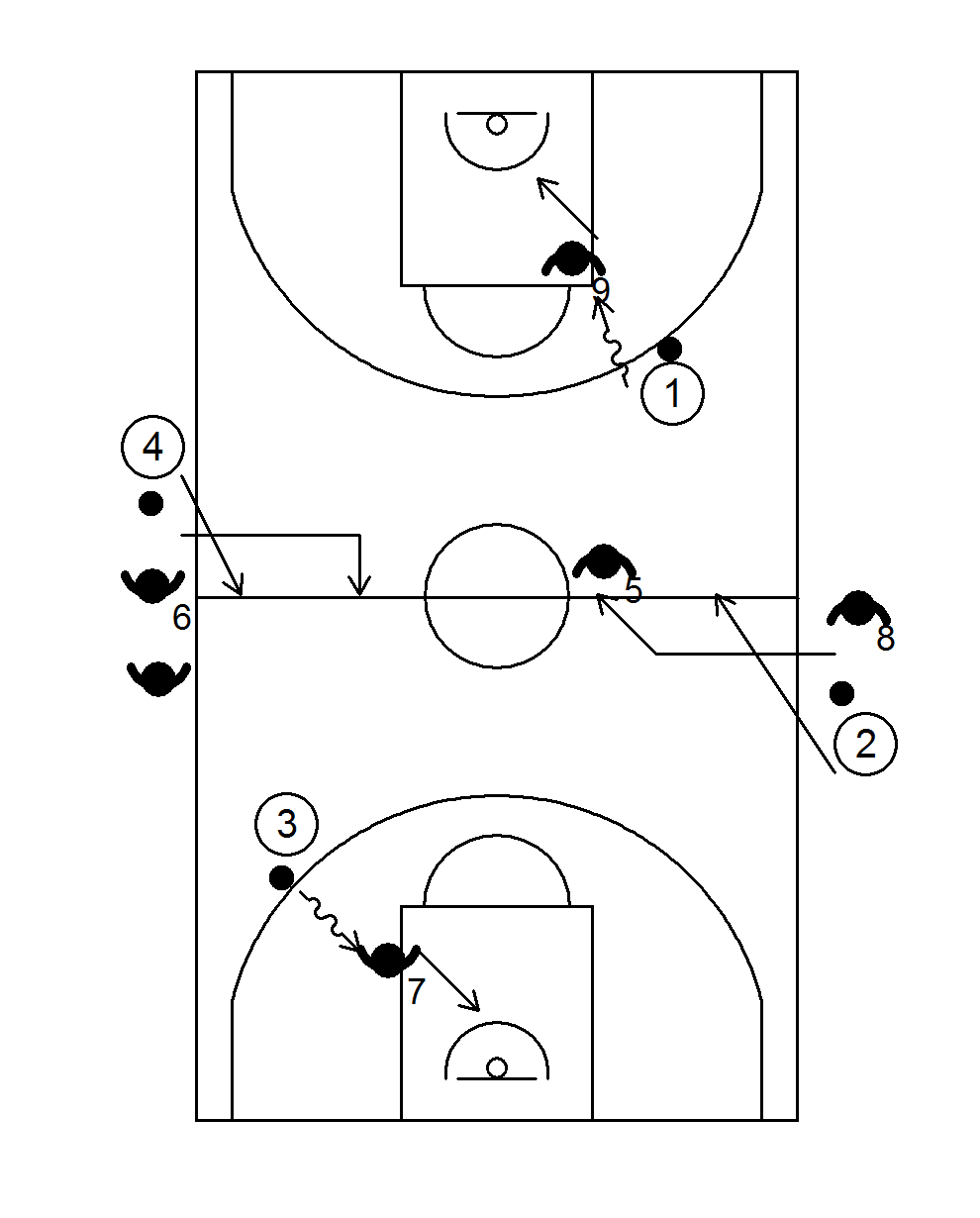
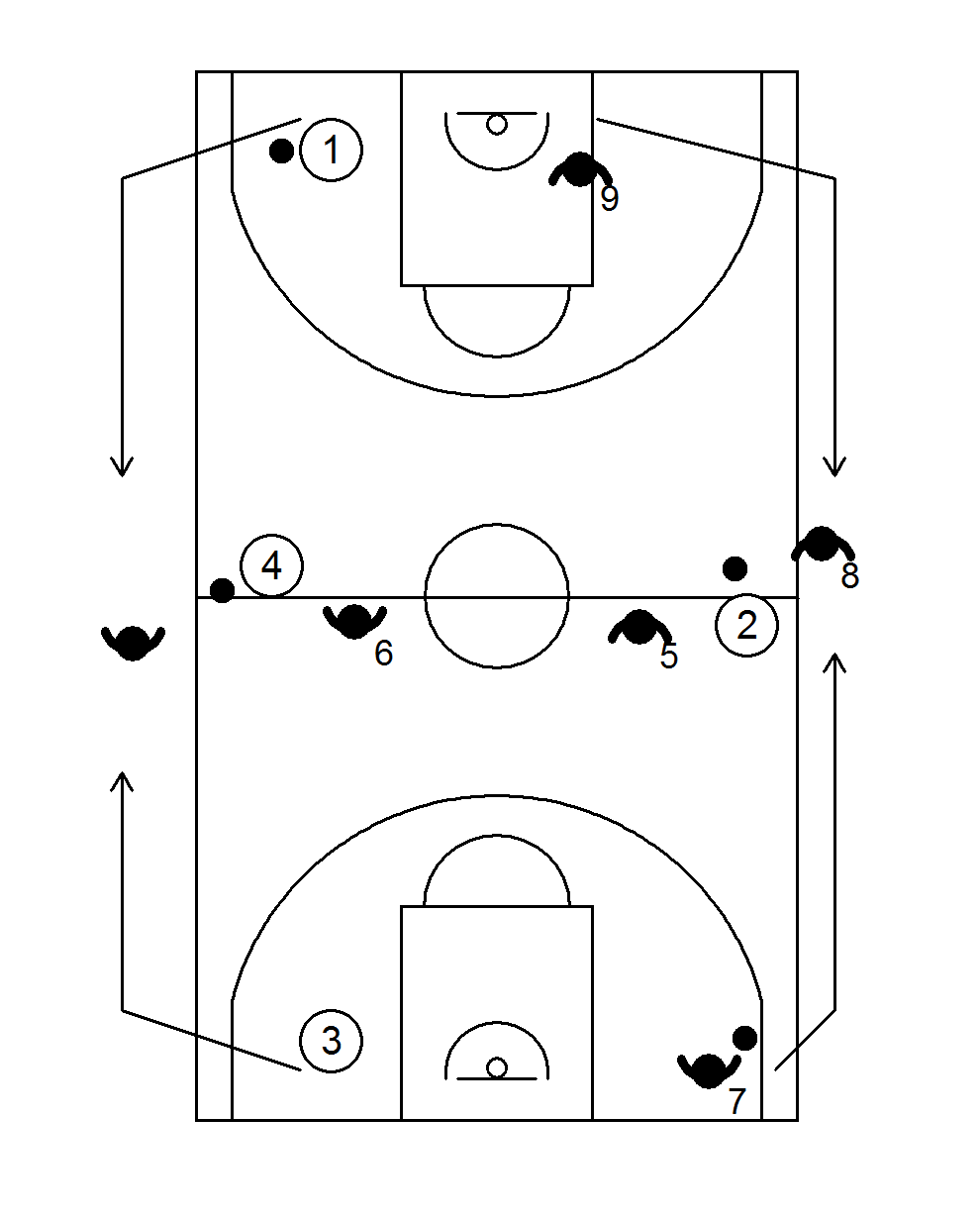
Requirements:
players must be able to defend the man with the ball individually (slides)
Goal: apply individual defensive technique in a simplified game situation
Organisation:
- attackers use one quarter of the playing field
- is not allowed to cross the baseline
- plays 1 against 1
- the defender may only step over the half-way line once the attacker has put one foot over the half-way line (the attacker may make feints, if the defender steps too early he must first put both his legs back behind the line)
- the defender first has to sprint to get his position between man and basket, then stay with slides between man and basket
- winner will attack on the other half of the court
- Loser keeps on defending in this quarter (turning in at the halfway line).
- the next pair starts when the predecessor takes the rebound.
Teaching Points:
- make sure you overtake the attacker by a large margin and only then take the defensive position.
- then immediately move backwards with slides
- In case of a defensive fault, the attacker is the winner.
Variations:
- let the defender keep his hands behind his back if you want to accentuate his footwork
- You can give good defenders a handicap by having them start 1 or 2 steps behind the attacker
- attackers can be slowed down by having them dribble behind their back in front of the 3-point line, etc.
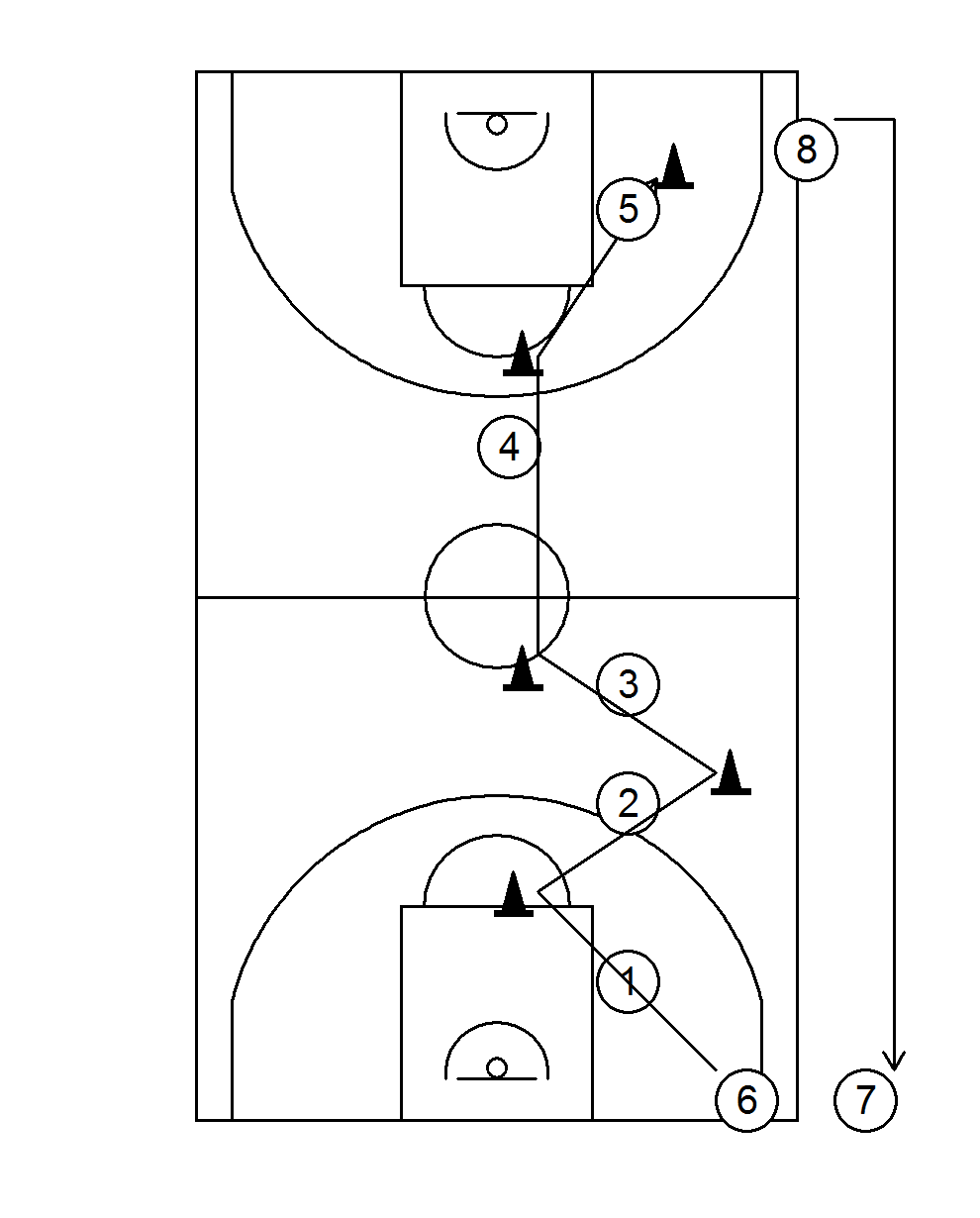
Goal: learn or improve drop step and side slides + condition
Organization:
- place 5 cones as shown
- vary distance and angle
- players move with slides from one pawn to the other
- at every cone they make a drop step and change hands from high to low and vice versa
- Always face the back line where the player started.
- between pawns 3 and 4, a short quick sprint (now with the face to the other back line)
- at pawn 4, turn 180 degrees, assume defensive position, drop step + slides to pawn 5
- in a quiet run back to the starting point
Teaching Points:
- Feet at least shoulder width.
- Knees at about 100 degrees (= sitting down deeply)
- shoulders above the heels (= back straight)
- Head straight up (overlook the field)
- Hand closest to the ball is low (to be able to tap the ball away on the dribble)
- Other hand is above the shoulder (to intercept a pass)
- push hard on the push-off leg to gain speed
- Feet stay low to the ground (= slide, shuffle)
- feet do not connect after a slide, but remain at shoulder width
- at the drop step, the foot closest to the ball moves backwards quite a bit; then the defender changes direction and the hands change from high to low and vice versa
- intermediate sprint must be quick (= simulate recovery of defensive position after the dribbler has passed the defender)
- take up position between pawn 4 and the basket and immediately with slides to pawn 5
Variations:
- let the defender keep his hands behind his back if you want to accentuate his feet and stance
- make bigger differences in the distance between the pawns and the angle they are placed to each other.
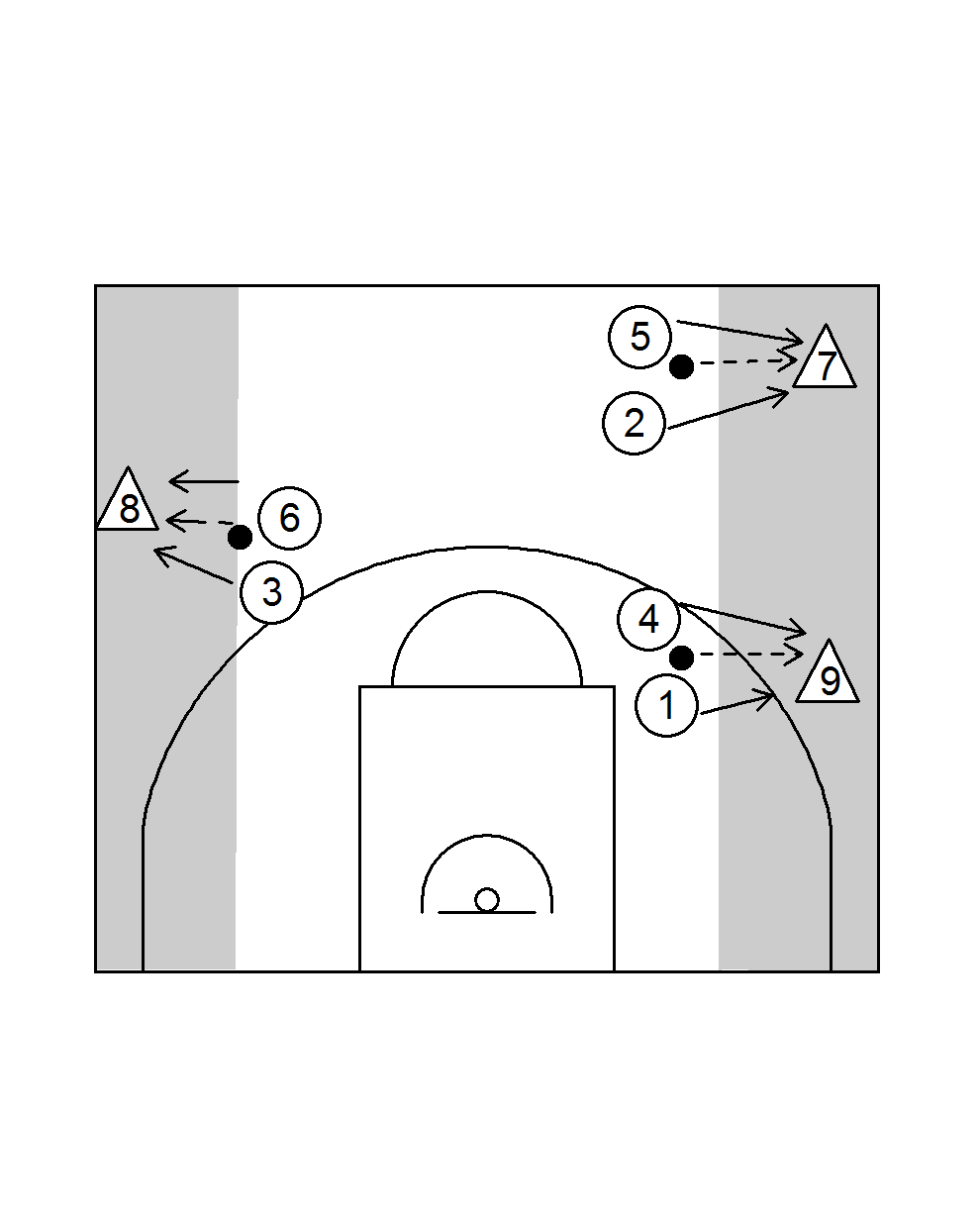
Goal: securing the dribbler against the sideline after stopping the dribble
Organisation:
- defender passes to attacker on signal of the coach
- Attacker is NOT allowed to dribble, only to pivot.
- the trainer counts down 5 seconds
Teaching Points:
- Get as close to the attacker as possible (but stay in your own cylinder).
- Move your feet closer to the attacker, but keep your position between the attacker and the helpline.
- If the attacker allows you to have his back, move your feet forward.
- trace the ball
- defenders always one hand low and one hand high (Umbrella)
- the attacker is never allowed to step or pass between the defenders (only passes parallel to the sideline are allowed)
- avoid mistakes; conquer ball by 1) 5 seconds, 2) bad pass, 3) attacker's foot on the line
Form of play:
Two additional attackers running free outside the lane. A successful pass between the defenders is a point for the attackers. 5 seconds or foot of the attacker on the line is a point for the defenders. Play to the 2.

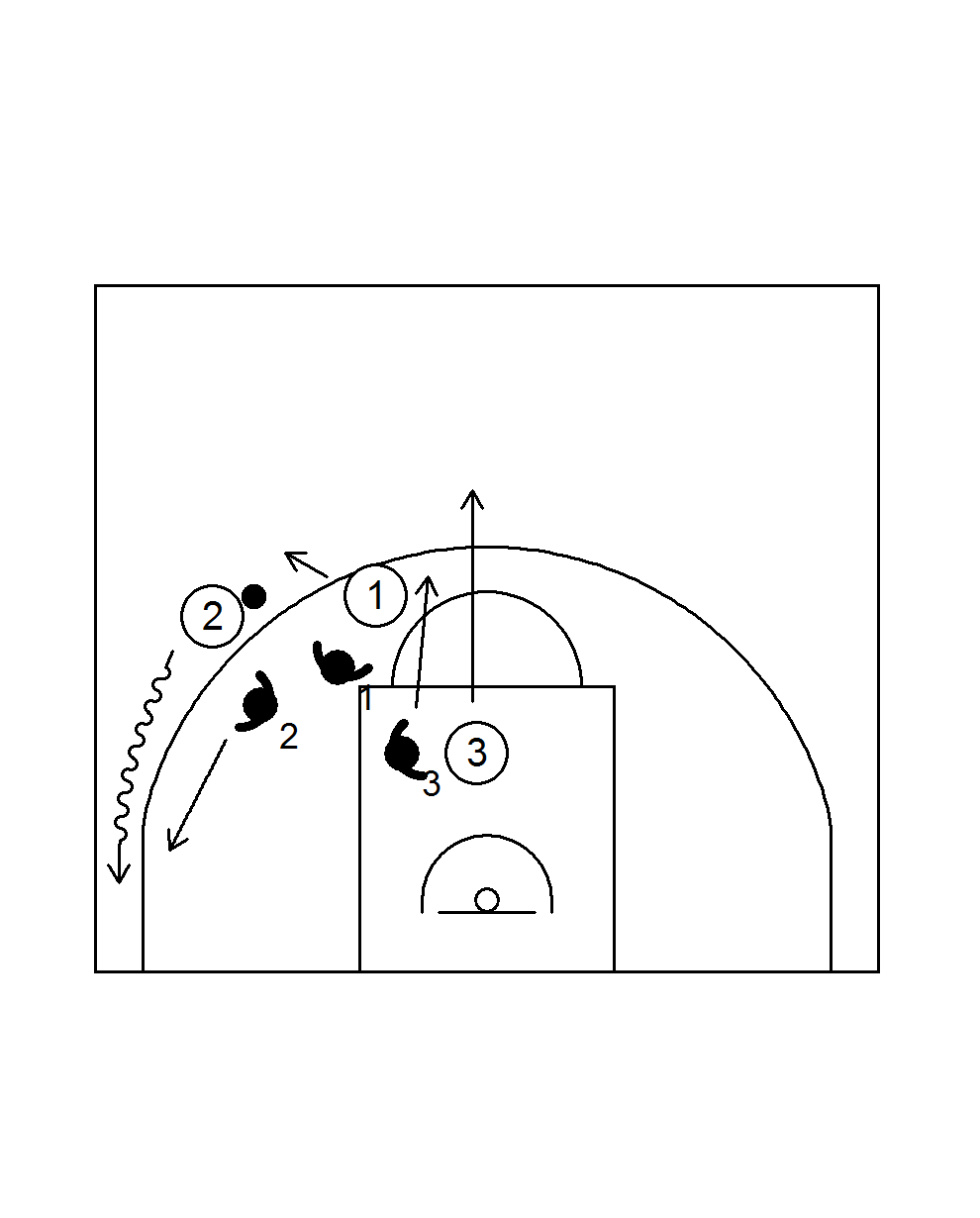
Goal: to defend one pass away
Organization:
- attackers use quarter of the field
- try to get free with in-out or cut
- first restore balance by occupying the 3 positions before cutting again
- defender overplays when his man is playable with one pass
- attacker can dribble
- a waiting player counts down 20 seconds
Teaching Points:
- hand in the passing line
- front foot in the passing line
- catch your man with your forearm
- 3/4 of your attention on the man, 1/4 on the ball
- NO help
- change after x stops
Form of play:
- each team gets 5x ball possession
- who makes the most stops
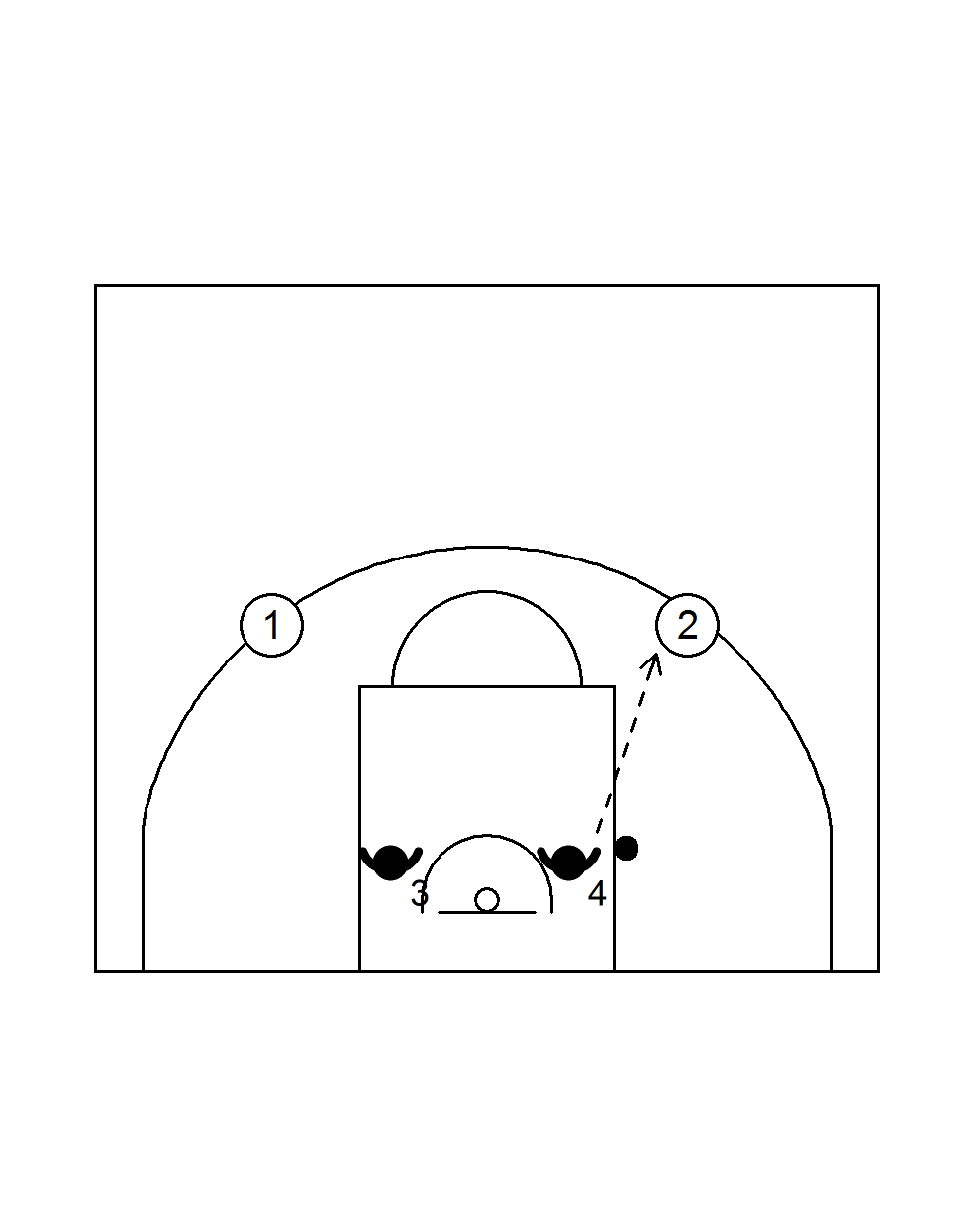
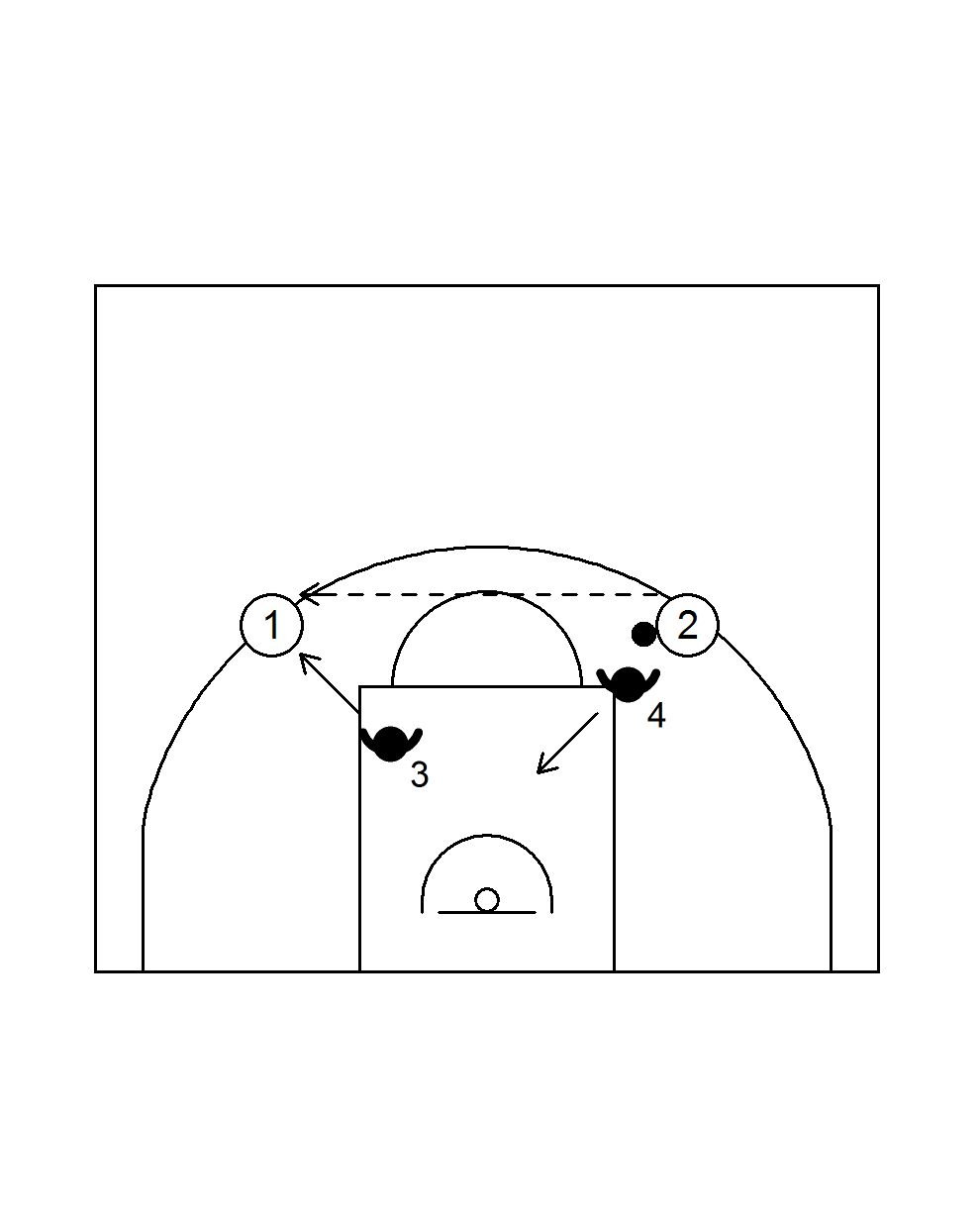
Requirements:
players must be able to play individually 1 against 1
Goal1: Improve the position change of the defender between helpside and ballside defense
Goal2: boxing out after the shot
Organisation:
- one of the defenders passes the ball from under the basket to an attacker
- A defender on the ball side closes the way to the basket (close out).
- the other defender takes the help side position: one foot in the bucket if the ball is above the free throw line; on the basket-basket line if the ball is below the free throw line
- When the ball is passed to the weak side, both defenders must quickly adjust their position relative to their man.
Substitutions:
- make it, take it
- or two is too much (push up defenders after 2 consecutive scores)
- (if you have more than 4 players, let the other players practice shooting at the other basket)
Teaching Points:
- Close out weak side shooter
- two explosive sprint steps, then lower your hips a bit + reduce step size
- inside foot in front
- outside hand in the shooter's face
- After the shot:
- immediately after the shot, both defenders must look at their man instead of the ball and box out
- put the forearm on the chest of the attacker
- box out with a front pivot or a reverse pivot and chase the ball
Variations:
- defenders may score from a rebound or interception
- the scoring team continues to attack
- play until the 7
Requirements:
- players must individually be able to defend the man with the ball
- players must know how to defend the man without the ball
Goal: To apply individual defensive technique in a simplified game situation
Organization:
- attackers use a quarter of the playing field
- are not allowed to cross the lifeline
- play 2 against 2
- winners will attack on the other half of the field
- losers keep on defending on this quarter (when there are more than 8 players, turn in at the halfway line)
Teaching Points:
- emphasise what you have taught the players individually
- there is no help (this makes it clear who is not defending well).
Variations:
- let the defender keep their hands behind their back if you want to emphasise footwork In the picture:
- Defenders 1 and 2 have conquered the ball without allowing attackers 1 and 2 to score
- defenders 1 and 2 attack on the other half of the pitch
- 5 and 6 will enter as defenders and play against the winners of 3 and 4
- former attackers 1 and 2 wait for their turn to defend
Prerequisites:
players must be quite proficient and in good physical condition
Organization:
after one team has scored 2 times the defenders go out of the field the winners get the ball
Ends when one team has won 5 times.
Losers have to work very hard physically afterwards. They should know this in advance so they will do their utmost to not lose.
If the MTM is not intense enough then the coach will award a score to the offensive side
Losers: (= minute drill: 45 sec full, 15 sec rest)
For each point difference in the score:
- 4 sprints back and forth across the field
- Push-ups until signal of the trainer
- 15 sec rest (players who lost by 1 point difference are finished)
- 4 sprints + sit ups until signal of the trainer
- 15 sec rest (players who lost by 2 points are finished)
- etc
If you are with 8 players:
- the two players who turn in ask one of the players who got out to join them
- players then count individually the number of times won
Two players throw the ball to each other, the ball may bounce. To make it more difficult the bouncing can be omitted. Also vary the distance.
The players stand in a circle and throw the ball to each other. They are not allowed to touch the ground. Try this with a player in the middle who is trying to intercept. If the ball is intercepted, the player who threw the ball stands in the middle.
Passer calls out a number - As soon as the passer has the ball in - after a certain time and the shooter runs to his hands, he calls out change, shooter becomes that spot to shoot from there again a number, at which passer and passer becomes shooter. the shooter again from that shooter. Remembering the scores.
Shooter catches own concerning the spot shoots. rebound and passes back
Show a "target" with your hands so the passer knows where you want the ball;
Stop correctly, for a rhythm stop let the inside foot land first and the old foot catch up. At a jump stop, the stop should actually not be audible. After the stop, jump straight up and come down in exactly the same place as you hit the ball
Walking into the ball, the pass is caught with 2 feet off the ground (in the run), ball is set if you catch it while already standing still
Feet pointing to the basket when you shoot. The landing is the same as your release, catch & shoot (good passing is essential here)
Don't bend your knees too far, but keep tension.
Arm dynamics: Elbow
under the shoulder, under the ball there, treasure arm is straight down, under the ball, higher release. first push the ball up and finish with your elbow above your eyebrows
The players dribble one by one in a zigzag fashion along the length of the playing field. When a player changes direction he/she bounces the ball under the legs and also changes hands.
The players practice the crossover technique. They start dribbling with their strong hand. Then the ball is bounced in a V-shape to the other hand. Make this exercise more difficult by running with the ball or a track.
The players try to dribble the ball behind their back. This works the same way as the crossover technique except the ball is not passed in front of the body but behind the back.
Player 1 dribbles across the width of the field, player 2 tries to tap the ball away. When this succeeds, the roles are reversed. Players are allowed to use several dribbling techniques.








